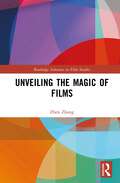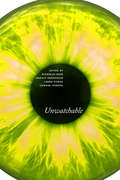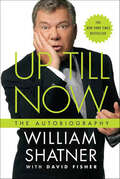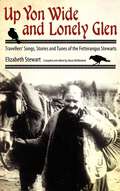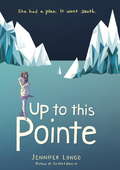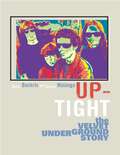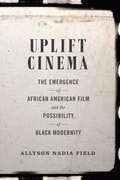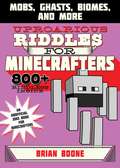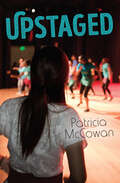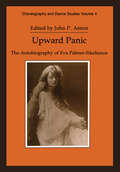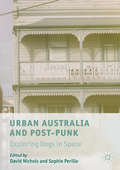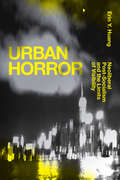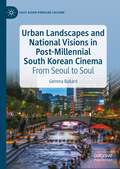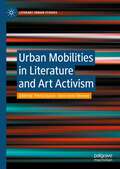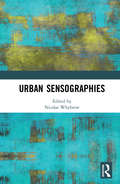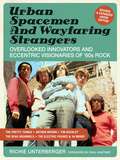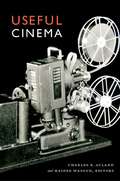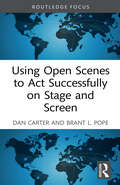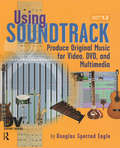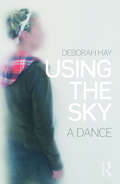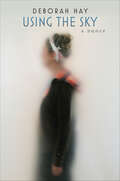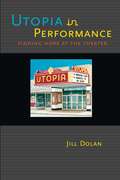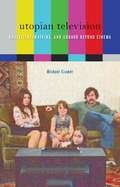- Table View
- List View
Unveiling the Magic of Films (Routledge Advances in Film Studies)
by Zhen ZhangThis book presents a comprehensive methodology for segmenting, transcribing, and analysing feature films, especially classical Hollywood films. It offers an in-depth study of three scenes from Roman Holiday (1953), each showcasing different combinations of verbal and non-verbal performance.Through detailed study, this book demonstrates how Roman Holiday can be broken down into Episodes, Events, Facts, Tasks, and Actions, while also exploring the semiotic modes involved in acting, art direction, cinematography, and editing. It reveals how acting constructs characters, relationships, situations, and the story’s generic structure, and examines how art direction, cinematography, and editing contribute to both performance and genre development. Building on these investigations, the book hypothesises performance features. These hypothesised features are subsequently tested on the Chinese film Raise the Red Lantern (1991), showcasing their flexibility and potential for broader application in film performance.The book makes a significant contribution to existing research by bridging film performance theories with social semiotics, synthesising them into a cohesive framework that is applicable to both Hollywood and non-Hollywood films. This book is especially valuable for scholars, practitioners, and students of film studies and social semiotics.
Unwatchable
by J. Hoberman Jonathan Rosenbaum Boris Groys Susie Bright Vivian Sobchack W.J.T. Mitchell Noel Carroll Bill Nichols Jonathan Crary Stefano Harney Jan Olsson Barbara Hammer B. Ruby Rich Fred Moten Mattias Frey Abigail De Kosnik E. Ann Kaplan Jeffrey Sconce Meghan Sutherland Michael Boyce Gillespie Christophe Wall-Romana Jennifer Malkowski Asbjørn Grønstad Jack Halberstam Jared Sexton Rebecca Schneider Frances Guerin Peter Geimer Alexandra Juhasz Julian Hanich Samuel England Mauro Resmini Katariina Kyrölä Erika Balsom Kenneth Berger Alex Bush Alec Butler Mel Chen Lynne Joyrich Nathan Lee Akira Lippit Brandy Monk-Payton Danielle Peers Raul Perez Elif Rongen-Kaynakçi Philipp Stiasny Bennet Togler Leshu Torchin Alok Vaid-Menon Meir Wigoder Emily Wills Federico Windhausen Stanley Wolukau-Wanambwa Genevieve Yue Alenka Zupancic Poulomi SahaWe all have images that we find unwatchable, whether for ethical, political, or sensory and affective reasons. From news coverage of terror attacks to viral videos of police brutality, and from graphic horror films to transgressive artworks, many of the images in our media culture might strike us as unsuitable for viewing. Yet what does it mean to proclaim something “unwatchable”: disturbing, revolting, poor, tedious, or literally inaccessible? With over 50 original essays by leading scholars, artists, critics, and curators, this is the first book to trace the “unwatchable” across our contemporary media environment, in which viewers encounter difficult content on various screens and platforms. Appealing to a broad academic and general readership, the volume offers multidisciplinary approaches to the vast array of troubling images that circulate in global visual culture.
Up Till Now: The Autobiography
by William Shatner David FisherThe autobiography of the famous TV, movie and theater star, who has played roles such as Captain James T. Kirk, Denny Crane, the Priceline negotiator, T. J. Hooker, and more.
Up Till Now: The Autobiography
by William Shatner David FisherAfter almost sixty years as an actor, William Shatner has become one of the most beloved entertainers in the world. And it seems as if Shatner is everywhere. In Up Till Now, Shatner sits down with readers and offers the remarkable, full story of his life and explains how he got to be, well, everywhere. It was the original Star Trek series, and later its films, that made Shatner instantly recognizable, called by name---or at least by Captain Kirk's name---across the globe. But Shatner neither began nor has ended his career with that role. From the very start, he took his skills as an actor and put them to use wherever he could. He straddled the classic world of the theater and the new world of television, whether stepping in for Christopher Plummer in Shakespeare's Henry V or staring at "something on the wing" in a classic episode of The Twilight Zone. And since then, he's gone on to star in numerous successful shows, such as T.J. Hooker,Rescue 911, and Boston Legal. William Shatner has always been willing to take risks for his art. What other actor would star in history's first---and probably only---all-Esperanto-language film? Who else would share the screen with thousands of tarantulas, release an album called Has Been, or film a racially incendiary film in the Deep South during the height of the civil rights era? And who else would willingly paramotor into a field of waiting fans armed with paintball guns, all waiting for a chance to stun Captain...er, Shatner?In this touching and very funny autobiography, William Shatner's Up Till Now reveals the man behind these unforgettable moments, and how he's become the worldwide star and experienced actor he is today."It is now Bill Shatner's universe---we just live in it."---New York Daily News
Up Yon Wide and Lonely Glen: Travellers' Songs, Stories and Tunes of the Fetterangus Stewarts
by Elizabeth StewartElizabeth Stewart is a highly acclaimed singer, pianist, and accordionist whose reputation has spread widely not only as an outstanding musician but as the principal inheritor and advocate of her family and their music. First discovered by folklorists in the 1950s, the Stewarts of Fetterangus, including Elizabeth's mother Jean, her uncle Ned, and her aunt Lucy, have had immense musical influence. Lucy in particular became a celebrated ballad singer and in 1961 Smithsonian Folkways released a collection of her classic ballad recordings that brought the family's music and name to an international audience. Up Yon Wide and Lonely Glen is a significant memoir of Scottish Traveller life, containing stories, music, and songs from this prominent Traveller family. The book is the result of a close partnership between Elizabeth Stewart and Scottish folk singer and writer Alison McMorland. It details the ancestral history of Elizabeth Stewart's family, the story of her mother, the story of her aunt, and her own life story, framing and contextualizing the music and song examples and showing how totally integrated these art forms are with daily life. It is a remarkable portrait of a Traveller family from the perspective of its matrilineal line. The narrative, spanning five generations and written in Scots, captures the rhythms and idioms of Elizabeth Stewart's speaking voice and is extraordinary from a musical, cultural, sociological, and historical point of view. The book features 145 songs, eight original piano compositions, folktale versions, rhymes and riddles, and eighty fascinating illustrations, from the family of Elizabeth, her mother Jean (1912–1962) and her aunt Lucy (1901–1982). In addition, there are notes on the songs and a series of appendices. Up Yon Wide and Lonely Glen will appeal to those interested in traditional music, folklore, and folk song—and in particular, Scottish tradition.
Up to This Pointe
by Jennifer LongoA refreshingly original contemporary YA, unlike anything readers have seen before. Perfect for fans of Jandy Nelson, John Corey Whaley, and Libba Bray. She had a plan. It went south. Harper is a dancer. She and her best friend, Kate, have one goal: becoming professional ballerinas. And Harper won't let anything--or anyone--get in the way of The Plan, not even the boy she and Kate are both drawn to. Harper is a Scott. She's related to Robert Falcon Scott, the explorer who died racing Amundsen and Shackleton to the South Pole. So when Harper's life takes an unexpected turn, she finagles (read: lies) her way to the icy dark of McMurdo Station . . . in Antarctica. Extreme, but somehow fitting--apparently she has always been in the dark, dancing on ice this whole time. And no one warned her. Not her family, not her best friend, not even the boy who has somehow found a way into her heart. It will take a visit from Shackleton's ghost--the explorer who didn't make it to the South Pole, but who got all of his men out alive--to teach Harper that success isn't always what's important, sometimes it's more important to learn how to fail successfully. "One of the most breathtaking explorations of navigating heartbreak that I've ever read. This is one for the ages." --Martha Brockenbrough, author of The Game of Love and Death "A moving love letter to dance, dreams, and San Francisco." --Kirkus Reviews Praise for Jennifer Longo's Six Feet Over It: A VOYA Perfect Tens 2014 Pick An Indies Introduce New Voices Pick "Like nothing you've read before." --Bustle.com "Equal parts poignant and humorous. . . . Superb." --Kirkus Reviews, Starred "A vibrant voice. . . . Readers will rejoice." --The Bulletin, Starred "A unique book for unique teens." --Booklist "Darkly funny and deeply moving. An original, memorable voice." --Jennifer L. Holm, New York Times bestselling author "A wildly funny coming-of-age story about life, love, death, and everything in between." --Sarah McCarry, author of All Our Pretty Songs "Terrific. Longo had me at 'graveyard' and then dug me in deeper with wit, dark humor, and splendid characters." --Lisa Brown, New York Times bestselling author "A strong heroine, multicultural cast, and eclectic contemporary setting make Longo's story stand out." --Publishers Weekly "Stands out for its unusual setting and also the sarcasm and caustic humor of its protagonist." --The Horn Book Review "Hilarious, clever, and poignant." --SLJFrom the Hardcover edition.
Up-Tight: The Velvet Underground Story
by Victor BockrisThe Velvet Underground is arguably one of the most influential American rock bands ever. Based on interviews with former members Lou Reed, John Cale, and Sterling Morrison, as well as others from Andy Warhol's circle of artistic collaborators, Up-Tight is the definitive oral and visual history of the band and its revolutionary, often avant-garde music. Bockris and Malanga's intelligent and entertaining approach-which does not shy away from the drugs, sleaze, and controversy that enveloped the band seemingly from its inception-provides compulsive reading.
Uplift Cinema: The Emergence of African American Film and the Possibility of Black Modernity
by Allyson Nadia FieldIn Uplift Cinema, Allyson Nadia Field recovers the significant yet forgotten legacy of African American filmmaking in the 1910s. Like the racial uplift project, this cinema emphasized economic self-sufficiency, education, and respectability as the keys to African American progress. Field discusses films made at the Tuskegee and Hampton Institutes to promote education, as well as the controversial The New Era, which was an antiracist response to D. W. Griffith's The Birth of a Nation. She also shows how Black filmmakers in New York and Chicago engaged with uplift through the promotion of Black modernity. Uplift cinema developed not just as a response to onscreen racism, but constituted an original engagement with the new medium that has had a deep and lasting significance for African American cinema. Although none of these films survived, Field's examination of archival film ephemera presents a method for studying lost films that opens up new frontiers for exploring early film culture.
Uproarious Riddles for Minecrafters: Mobs, Ghasts, Biomes, and More (Jokes for Minecrafters)
by Brian Boone Amanda BrackUproarious Riddles for Minecrafters is the fifth book in the Jokes for Minecrafters series, which is complete with more than eight hundred riddles! "Dig in" to these funny brainteasers about Minecraft mobs, tools, and biomes that will really make you think! You'll have such a BLAST reading all of these crafty riddles and jokes. All of your favorite parts of the Minecraft game are included in the book, and the riddles will have you continuing the Minecraft fun! <p><p> For kids ages five and up, this is the perfect book for at home, at school, or really anywhere! You’ll enjoy telling these silly jokes to your friends and family. As a bonus there are silly illustrations throughout for extra laughs!
Upstaged (Orca Limelights)
by Patricia McCowanEllie is used to getting leading roles in her small-town school’s musicals, but her place at center stage disappears when her dad becomes the host of a breakfast TV show and they have to move to the big city. When Ellie auditions for—and lands—a spot with the Youth Works Theater Company, she comes up against a tight-knit group of talented, experienced and competitive triple-threat performers. Not only does she not get a lead, but she has to share a role with Marissa, a company veteran who seems determined to do all she can to outshine Ellie. Out of her depth and far from all that she’s known, Ellie wonders just what she has to do to stop feeling upstaged by everyone around her. This short novel is a high-interest, low-reading level book for middle-grade readers who are building reading skills, want a quick read or say they don’t like to read! The epub edition of this title is fully accessible.
Upward Panic: The Autobiography of Eva Palmer-Sikelianos (Choreography and Dance Studies Series #Vol. 4.)
by John P. AntonFirst Published in 1993.A complete autobiography of Evalina Palmer-Sikelianos (1874-1952), a woman of immense spiritual strength who fought for the arts against the background of war. She contributed impressively throughout her life to the revival of interest in classical Greece, the theatre and choral dance, and advocated an adherence to mythical authenticity rather than a romanticised view of Greek tragic drama.
Urban Australia and Post-Punk: Exploring Dogs in Space
by David Nichols Sophie PerilloRichard Lowenstein’s 1986 masterpiece Dogs in Space was and remains controversial, divisive, compelling and inspirational. Made less than a decade after the events it is based on, using many of the people involved in those events as actors, the film explored Melbourne’s ‘postpunk’ counterculture of share houses, drugs and decadence. Amongst its ensemble cast was Michael Hutchence, one of the biggest music stars of the period, in his acting debut. This book is a collection of essays exploring the place, period and legacy of Dogs in Space, by people who were there or who have been affected by this remarkable film. The writers are musicians, actors and artists and also academics in heritage, history, urban planning, gender studies, geography, performance and music. This is an invaluable resource for anyone passionate about Australian film, society, culture, history, heritage, music and art.
Urban Crime Control in Cinema: Fallen Guardians and the Ideology of Repression (Palgrave Studies in Crime, Media and Culture)
by Vladimir RizovThis book uses popular films to understand the convergence of crime control and the ideology of repression in contemporary capitalism. It focuses on the cinematic figure of the fallen guardian, a protagonist who, in the course of a narrative, falls from grace and becomes an enemy of the established social order. The fallen guardian is a figure that allows for the analysis of a particular crime control measure through the perspective of both an enforcer and a target. The very notion of ‘justice’ is challenged, and questions are posed in relation to the role that films assume in the reproduction of policing as it is. In doing so, the book combines a historical far-reaching perspective with popular culture analysis. At the core remains the value of the cinematic figure of the fallen guardian for contemporary understandings of urban space and urban crime control and how films are clear examples of the ways in which the ideology of repression is reproduced.This book questions the justifications that are often given for social control in cities and understands cinema as a medium for offering critique of such processes and justifications. Explored are the crime control measures of private policing in relation to RoboCop (1987), preventative policing and Minority Report (2002), mass incarceration in The Dark Knight Rises (2012), and extra-judicial killing in Blade Runner 2049 (2017). The book speaks to those interested in crime control in critical criminology, cultural criminology, urban studies, and beyond.
Urban Horror: Neoliberal Post-Socialism and the Limits of Visibility (Sinotheory)
by Erin Y. HuangIn Urban Horror Erin Y. Huang theorizes the economic, cultural, and political conditions of neoliberal post-socialist China. Drawing on Marxist phenomenology, geography, and aesthetics from Engels and Merleau-Ponty to Lefebvre and Rancière, Huang traces the emergence and mediation of what she calls urban horror—a sociopolitical public affect that exceeds comprehension and provides the grounds for possible future revolutionary dissent. She shows how documentaries, blockbuster feature films, and video art from China, Hong Kong, and Taiwan made between the 1990s and the present rehearse and communicate urban horror. In these films urban horror circulates through myriad urban spaces characterized by the creation of speculative crises, shifting temporalities, and dystopic environments inhospitable to the human body. The cinematic image and the aesthetics of urban horror in neoliberal post-socialist China lay the groundwork for the future to such an extent, Huang contends, that the seeds of dissent at the heart of urban horror make it possible to imagine new forms of resistance.
Urban Landscapes and National Visions in Post-Millennial South Korean Cinema: From Seoul to Soul (East Asian Popular Culture)
by Gemma BallardThis book explores South Korean cinema’s inimitable relationship with the urban landscape and identifies the ways in which Seoul is utilised as a celluloid canvas, national artefact and, above all else, a distinctive cultural backdrop. Using five different approaches to urban space, from five distinctive and contrasting theoretical perspectives, Urban Landscapes in Post-Millennial South Korean Cinema investigates and seeks to understand why the cinematic representation, identity and presence of Seoul have been central to the preservation and recognition of the South Korean film industry as an independent, autonomous and nationally unique institution.
Urban Mobilities in Literature and Art Activism (Literary Urban Studies)
by Patricia García Anna-Leena ToivanenUrban Mobilities in Literature and Art Activism explores the entwinement of mobility and immobility in urban spaces by focusing on their representation in literary narratives but also in visual and performing arts. Across a range of geographical contexts, this volume builds on the new mobilities paradigm developed by literary scholars, sociologists and human geographers. The different chapters employ a cohesive framework that is sensitive to the intersecting dimensions of power and discrimination that shape urban kinetic features. The contributions are divided into three sections, each of which places the focus on a different aspect of urban mobility: Itinerant Subjects, Modes of Transport and Places of Transit, and Urban Liminalities.Chapter 7, "Alienation, Abjection and the Mobile Postcolonial City: Public Transport in Ousmane Sembène’s “Niiwam” and Yvonne Vera’s Without a Name" is available open access under a Creative Commons Attribution 4.0 International License via link.springer.com.
Urban Sensographies
by Nicolas WhybrowUrban Sensographies views the human body as a highly nuanced sensor to explore how various performance-based methods can be implemented to gather usable ‘felt data’ about the environment of the city as the basis for creating embodied mappings. The contributors to this fascinating volume seek to draw conclusions about the constitution, character and morphology of urban space as public, habitable and sustainable by monitoring the reactions of the human body as a form of urban sensor. This co-authored book is centrally concerned, as a symptom of the degree to which cities are evolving in the 21st century, to examine the effects of this change on the practices and behaviours of urban dwellers. This takes into account such factors as: defensible, retail and consumer space; legacies of modernist design in the built environment; the effects of surveillance technologies, motorised traffic and smart phone use; the integration of ‘wild’ as well as ‘domesticated’ nature in urban planning and living; and the effects of urban pollution on the earth’s climate. Drawing on three years of funded practical research carried out by a multi-medial team of researchers and artists, this book analyses the presence and movement of the human body in urban space, which is essential reading for academics and practitioners in the fields of dance, film, visual art, sound technology, digital media and performance studies.
Urban Spacemen and Wayfaring Strangers
by Richie Unterberger"Urban Spacemen & Wayfaring Strangers: Overlooked Innovators & Eccentric Visionaries of '60s Rock" documents twenty cult rockers from the 1960s. The book features extremely detailed investigation of the careers of greats like the Pretty Things, Arthur Brown, Richard & Mimi Fariña, and Tim Buckley. Also featured are the Bonzo Dog Band, the Electric Prunes, Bobby Fuller, the Fugs, Kaleidoscope, Fred Neil, the Beau Brummels, Thee Midniters, Dino Valenti, Mike Brown of the Left Banke, and others, including producers Shel Talmy (the Who, the Kinks, Pentangle) and Giorgio Gomelsky (the Yardbirds, Julie Driscoll, the Soft Machine). In all cases, the extensive chapters include first-hand interview material with the artists themselves and/or their close associates. Lost British Invaders, psychedelic pioneers, rock funnymen, blue-eyed soulsters, overlooked folk-rockers, behind-the-scenes producers -- all find a home as part of "Urban Spacemen & Wayfaring Strangers," with a foreword by Paul Kantner of Jefferson Airplane. The ebook version of "Urban Spacemen & Wayfaring Strangers" is significantly expanded, revised, and updated from the print version, adding 20,000 words of new material. The text is accompanied by illustrations and reviews of the most essential recordings by each artist. From reviews of "Urban Spacemen":"[He] brings to this volume a true fan's love of music combined with a writer's smarts and skills. He seamlessly combines researched material with new interviews. . . Not only did Unterberger choose well musically, but he found the momentum and heart of each of their stories. " -- David Greenberger (essayist on National Public Radio's "All Things Considered"), Pulse!"These fascinating tales will make you want to rush out to the record store -- a hallmark of all great music writing. " -- Jim DeRogatis, Chicago Sun-Times"In each fascinating case study the author tracks down one or more former group members and/or principals in the story, which gives his work both authority and freshness. . . his overall handling of the material is exemplary. "Urban Spacemen" forms a compelling mosaic of the hopes and dreams -- not to mention sharp business practices -- of the decade. " -- Mike Barnes (author of the biography "Captain Beefheart"), The Wire
Useful Cinema
by Haidee Wasson Charles R. AclandBy exploring the use of film in mid-twentieth-century institutions, including libraries, museums, classrooms, and professional organizations, the essays in Useful Cinema show how moving images became an ordinary feature of American life. In venues such as factories and community halls, people encountered industrial, educational, training, advertising, and other types of "useful cinema." Screening these films transformed unlikely spaces, conveyed ideas, and produced subjects in the service of public and private aims. Such functional motion pictures helped to shape common sense about cinema's place in contemporary life. Whether measured in terms of the number of films shown, the size of audiences, or the economic activity generated, the "non-theatrical sector" was a substantial and enduring parallel to the more spectacular realm of commercial film. In Useful Cinema, scholars examine organizations such as UNESCO, the YMCA, the Amateur Cinema League, and the Metropolitan Museum of Art. They also consider film exhibition sites in schools, businesses, and industries. As they expand understanding of this other American cinema, the contributors challenge preconceived notions about what cinema is. Contributors. Charles R. Acland, Joseph Clark, Zoë Druick, Ronald Walter Greene, Alison Griffiths, Stephen Groening, Jennifer Horne, Kirsten Ostherr, Eric Smoodin, Charles Tepperman, Gregory A. Waller, Haidee Wasson. Michael Zryd
Using Open Scenes to Act Successfully on Stage and Screen
by Dan Carter Brant L. PopeUsing Open Scenes as a "way in" to scripted material, this book establishes a foundational actor training methodology that can be applied to the performance of film or television acting, commercials, and theatrical realism. Unlike other methodologies, this unique approach is devoid of casting considerations or imposed identity, providing actors opportunities that do not rely on nor are restricted by age, gender, race, ethnicity, regional accent, body type, identity, or other defining or delimiting aspects that come into play during the casting process. This allows the actor to focus on personal authenticity as they develop their skills. This book will appeal to undergraduate students, acting teachers, and the contemporary actor seeking a career in film, television, or other electronic media. Visit the companion website www.usingopenscenestoactsuccessful.godaddysites.com for additional Open Scenes and more.
Using Soundtrack: Produce Original Music for Video, DVD, and Multimedia (Dv Expert Ser.)
by Douglas Spotted EagleCovering the basics of producing great audio tracks to accompany video projects, Using Soundtrack provides recording and editing tips and guidance on noise reduction tools, audio effects, and Final Cut Pro's powerful real-time audio mixer. Readers also learn how Soundtrack can be used to give video projects a professional finish with the addition of custom, royalty-free scoring. Theory is presented on a need-to-know basis and practical tutorials provide hands-on techniques for common tasks, including editing video to audio, editing audio to video, changing the length of a music bed, editing dialog, and mixing dialog with music and sound effects. The accompanying CDROM includes tutorial lessons and sample media.
Using the Sky: A Dance
by Deborah HayIn the mid 1990’s Deborah Hay’s work took a new turn. From her early experiments with untrained dancers, and after a decade of focusing on solo work, the choreographer began to explore new grounds of choreographic notation and transmission by working with experienced performers and choreographers. Using the Sky: a dance follows a similar path as Hay’s previous books—Lamb at the Altar and My Body the Buddhist—by exploring her unrelenting quest for ways to both define and rethink her choreographic imagery through a broad range of alternately intimate, descriptive, poetic, analytical and often playful engagement with language and writing. This book is a reflection on the experiments that Hay set up for herself and her collaborators, and the ideas she discovered while choreographing four dances, If I Sing to You (2008), No Time to Fly (2010), A Lecture on the Performance of Beauty (2003), and the solo My Choreographed Body (2014). The works are revisited by unfolding a trove of notes and journal entries, resulting in a dance score in its own right, and providing an insight into Hay’s extensive legacy and her profound influence on the current conversations in contemporary performance arts.
Using the Sky: A Dance
by Deborah HayDeborah Hay is an internationally renowned dance artist whose unique approach to bodily practice has had lasting impact on American choreography. Her commitment to dance as a process is as exquisite as it is provoking. Rooted in NYC's 1960s experimental Judson Dance Theater in New York, Hay's work has evolved through experimentation with a use of language that is unique to dance. This book is an exploration and articulation of Hay's process, focusing on several of her most recent works.
Utopia in Performance
by Jill DolanLive performance can provide people with inspiration for an improved world, Dolan argues, one that seems to be slipping further away since 9/11. As examples, she analyzes autobiographical performances by feminists Holly Hughes, Peggy Shaw, and Deb Margolin; multiple- character monologues by Lily Tomlin, Danny Hoch, and Anna Deavere Smith; the political suggestions of Russell Simmons Def Poetry Jam on Broadway and The Laramie Project; and radical humanism in Ann Carlson's Blanket, Mary Zimmerman's Metamorphoses, and Deborah Warner and Fiona Shaw's Medea. Annotation ©2006 Book News, Inc. , Portland, OR (booknews. com)
Utopian Television: Rossellini, Watkins, and Godard beyond Cinema
by Michael CramerTelevision has long been a symbol of social and cultural decay, yet many in postwar Europe saw it as the medium with the greatest potential to help build a new society and create a new form of audiovisual art. Utopian Television examines works of the great filmmakers Roberto Rossellini, Peter Watkins, and Jean-Luc Godard, all of whom looked to television as a promising new medium even while remaining critical of its existing practices.Utopian Television illustrates how each director imagined television&’s improved or &“utopian&” version by drawing on elements that had come to characterize it by the early 1960s. Taking advantage of the public service model of Western European broadcasting, each used television to realize works that would never have been viable in the commercial cinema. All three directors likewise seized on television&’s supposed affinity for information and its status as a &“useful&” medium, but attempted to join this utility with aesthetic experimentation, suggesting new ways to conceive of the relationship between aesthetics and information.As beautifully written as it is theoretically rigorous, Utopian Television turns to the writing of Fredric Jameson and Ernst Bloch in treating the three directors&’ television experiments as enactments of &“utopia as method.&” In doing so it reveals the extent to which the medium inspired and shaped hopes not only of a better future but of better moving image art as well.
